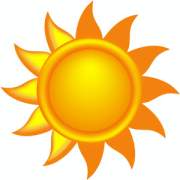Best Sources of Vitamin D
Looking for good sources of vitamin D? Then look to the sky.
The sun is how we were designed to get our vitamin D dosage – just a couple of hours per week is all we need. Although with our modern indoor lifestyles, even that can be a challenge.

And then of course there are other factors that impact our vitamin D levels.
You'll need more sunlight exposure or additional sources of vitamin D if you:
- have dark skin
- are overweight or obese
- are older than 60
- live around smog/air pollution
- wear long sleeves/pants outside
- slather on the sunblock
It also depends on where you live. For most of us in the U.S,. our skin can only make vitamin D during the summer months. The rest of the year simply doesn't provide strong enough UVB rays to convert sunlight into this critical nutrient.
Although, even in the best possible situations, we are finding that the vast majority of us are vitamin D deficient.
In 2006, a check on vitamin D blood concentrations in our sunniest state (Arizona) found that 77% of Arizonans were deficient. Only 22.7% had close to adequate vitamin D levels of over 30 ng/ml (75 nmol/L).
However, most researchers studying this vitamin are in agreement that our vitamin D levels need to be over 50 ng/ml (125 nmol/L) to provide the most health benefits (including cancer prevention).
So we obviously aren't getting enough of the sunshine vitamin the way nature intended.
This isn't really all that surprising though, is it? We have become an indoor society that fears the sun. The sad part of that is vitamin D at high enough levels provides protection against skin cancer.
Now I'm not saying to burn yourself to a crisp – sunburns are never healthy. But if your goal is to remain as pasty as a vampire, perhaps you need to reevaluate sensible sun exposure. Definitely put away that umbrella for when it's actually raining.
Don't convince yourself that you can get all the vitamin D you need from food either.
Although some foods contain reasonable amounts of this vitamin, none of them are high enough to be able to eat your way out of a deficiency. They will, however, prevent you from getting rickets.
So what are the best food sources of vitamin D? Oily fish like mackerel, sardines, salmon, and tuna.
Note these fish are also excellent sources of omega-3.
But pollution should be a concern when it comes to certain kinds of fish. Here are some tips to keep in mind:
- Mackerel is fine, but avoid king mackerel which is very high in mercury.
- Salmon should be wild caught. Farm-raised fish are low in vitamin D and high in PCBs.
- You should choose canned chunk lite tuna, which has 3 times less mercury than albacore.
Despite what you've heard, fortified foods are not good sources of vitamin D. They have too little for good health, unless you like drinking 50 glasses of milk per day....
Cod liver oil used to be a great source of vitamin D, but most no longer contain any of the vitamin thanks to harsh processing methods.
If you see a bottle of cod liver oil that says it has vitamin D, it more than likely has been added back in artificially. And if you are going to take supplements, you might as well have complete control over which supplement you choose.
The bottom line is that, for most of us, vitamin D supplements are necessary. Lucky for us, there is a bio-available (easily utilized) natural vitamin D supplement that we can take.
Health and Wellness Home - Benefits of Vitamin D - Sources of Vitamin D